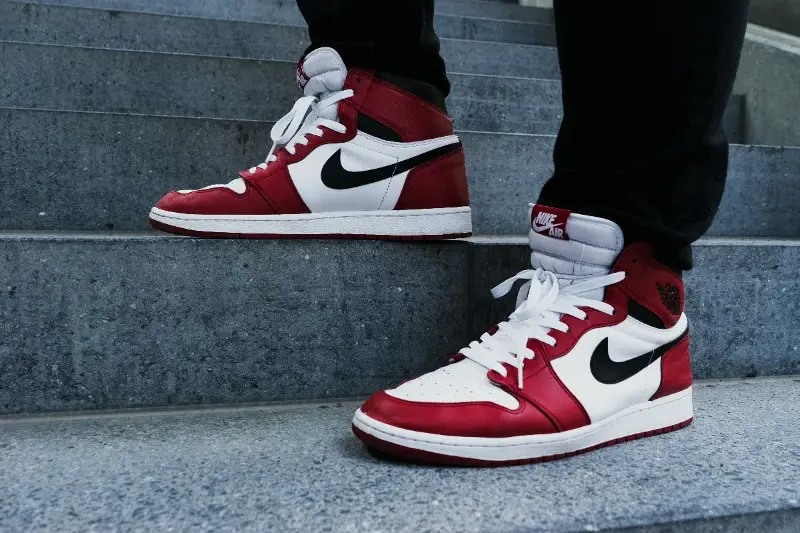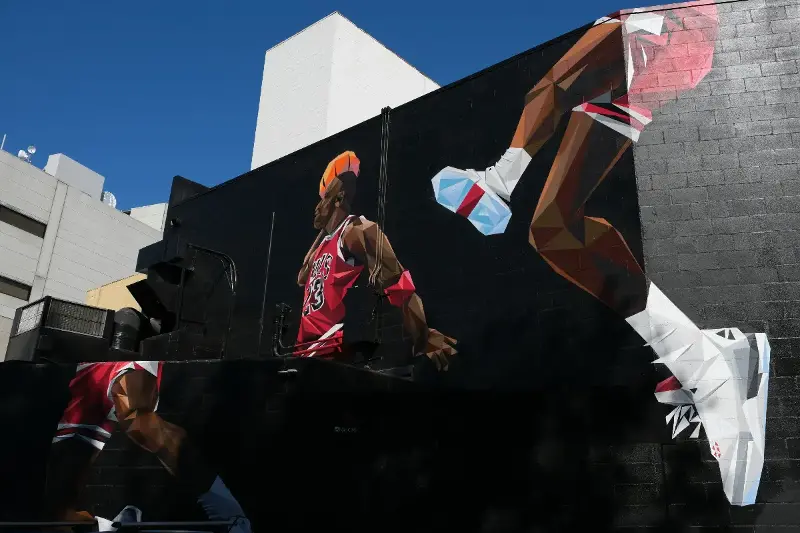
The legacy of Michael Jordan looms large over the game of basketball. His dominance, skillset and relentless approach earned him many nicknames in his years on the hardwood: “His Airness,” “The Black Cat,” “Air Jordan” but most notably: the GOAT, the Greatest Of All Time.
For decades, Jordan’s name has been synonymous with excellence. His name lingers with an air of reverence in every room. His level of greatness is so ubiquitous that people use his namesake as a measuring stick in other realms. Everyone wants to be “the Michael Jordan of” something.
In 1985, Nike made a fraction of that greatness available to the public with the release of the Air Jordan 1, and the rest is history. That sneaker spawned Jordan Brand, a line dedicated and engineered to suit Michael’s on-the-court exploits. That line would jump-start sneaker culture and even turn Michael’s most bitter rivals into admirers. Just ask Knicks superfan Spike Lee.
Now, Jordan Brand is celebrating 40 years of flight in style, including a global one-on-one tournament showcasing the world’s best high school players and, of course, new sneakers.
Newsweek spoke with the president of Jordan Brand, Sarah Mensah, to discuss the 40-year legacy of Air Jordan, where they go from here, and the impact female ballers are already leaving on the sport and its fashion.
Taking Flight

To truly highlight that legacy, Jordan Brand had to take it back to where it all began, before the six NBA championship titles, the NCAA championship or any of the endless accolades earned by Jordan.
In August, Jordan Brand hosted The One tournament, a global one-on-one basketball competition inspired by Michael’s own childhood basketball games against his older brother, Larry.
“It was intense and it was super competitive,” Mensah said of the brand’s tournament inspired by the Jordan brothers’ childhood battles. “I would argue that probably most people access basketball in that way, especially the first time.”
Those battles forged Michael into the player and icon he would go on to become. Michael learned during those brotherly basketball games that he couldn’t run from pressure. He had to break through it, just as he would go on to break through that tough “Bad Boys” Detroit Pistons defense that cooked up a set of “Jordan Rules” specifically designed to slow him down.
But that’s not the only origin story at play.
“We had to really start with the very beginning, which is when MJ stepped on the court in those colorful AJ ones and was banned, broke rules, and we really realized that there was really something in that this has always been a brand of disruption. It’s always been a brand that pushes the edges within sport and within culture,” reflected Mensah.
Michael Jordan’s final retirement came in 2003 after a stint with the Washington Wizards, but Air Jordan remains as popular as ever in the two decades since he last laced them up on the court. “Our approach to celebrating 40 years really set out to remind people of that and to talk about all the moments across the history of the Jordan Brand,” Mensah said. “We’ve really challenged the status quo, especially within sport, and really pushed both the culture of sport and the culture of basketball forward.”
Unsurprisingly, the Jordan Brand draws from the ethos of Jordan himself. For the 1996-97 NBA season, Jordan donned the Air Jordan 12, which famously featured “quality inspired by the greatest player ever” stitched on the heel tab. Jordan would wear that sneaker en route to his fifth title and famously while battling an illness in the 1997 Finals. That level of dedication and excellence set a high bar. Something with MJ’s name on it just can’t afford to be second-best.
“We always start with that blueprint, and that blueprint being excellence, we need to approach it with excellence. That means we need to be diligent,” Mensah said. “We need to work harder, we need to be faster, we need to be better, we need to be more elevated, because that’s what consumers have really expected from this brand, and that’s what makes this brand the brand of greatness.”
That level of greatness is the source of modern-day mythmaking. Few would get out of bed with the flu-like symptoms that ailed Jordan in Game 5 of the 1997 NBA Finals. Pouring in 38 points while ill to take the series lead in the Finals is the stuff of legend. Whereas the greats of the past had their exploits shared orally, Air Jordan’s tale had the added bonus of being retold to a new generation through a captivating documentary. “It was wonderful that ‘The Last Dance’ happened because it provided an opportunity for a lot of consumers that had never seen MJ play or never really experienced or heard the stories, to hear those stories firsthand.”
Mensah credited ESPN’s documentary as crucial in introducing this mystical figure to the next generation, some of whom never had the chance to watch MJ play. “We connect through story, and we remember the things that our elders sort of shared with us and taught us, and those stories are retranslated into new themes, but the essence of what the messages are that are in those stories stay the same.”
Jordan Brand is extremely aware of the role storytelling plays in the culture, but even without the tales, Air Jordan’s silhouette rings bells. That leaping logo transcends generations, and to Mensah, symbolizes greatness in every thread.
“They know it’s a brand that’s all about a phenomenal basketball player. They know it’s about greatness, and they know that symbol that is the Jumpman, when it’s put on your shoulder or on your shoe. It stands for you’re taking your game, you’re taking your execution, whatever it could be, to the next level,” Mensah said regarding the iconic Jumpman symbol.
Over time, Jordan Brand has evolved from wanting to “be like Mike” to unlocking one’s inner Jordan. “Innate greatness and winning and finding your game and finding your best now is sort of transcending from being just about him into other teams and in athletes and folks that were inspiring,” she continued.
A New Future of Flight
Air Jordans are still seen as the ultimate combination of cool and quality, even 40 years on from their intro on the hardwood. Each year, basketball players, Jordan fans and sneaker heads alike clamor for the latest year’s release.
Maintaining that level of quality with yearly releases is no small feat, especially for a hallmark year like the 40th anniversary. For Jordan Brand, each iteration has to remain true to the effortless swagger of MJ and his relentlessness as a competitor: “The Jordan that launches every year is the game shoe and has to be the most innovative performance basketball shoe in the market.”
The latest flagship release, the Air Jordan 40, celebrates Jordan’s vaunted sneaker line with Easter eggs found throughout the sneaker’s makeup, while also being made “first and foremost to perform.”
“The challenge of that launch every year is that it has to not only be ready to perform, but also has to be ready to perform off the court. It’s got that double challenge of being super lifestyle relevant, as well as being innovative in performance. I’d say innovation should come first, and then being relevant off the court is also equally important, and that’s also a signature point of view from the Jordan Brand,” Mensah said on the Air Jordan 40.
A League of Their Own

Elsewhere on the hardwood, Jordan Brand was an early supporter of women’s hoops. It crafted its first-ever sneaker designed for the women’s game in 1998 with the Women’s Air Jordan OG, making the WNBA’s ascent even more meaningful to Mensah. “It is so gratifying that the beauty of women’s basketball is finally having its day in the sun.”
Throughout her playing career with the Minnesota Lynx, Maya Moore held the torch for the Jordan Brand on the women’s side of the sport, donning the Jumpman on her way to four WNBA titles. Moore took center stage at The One Global Final at Pier 17 in New York City, where they honored her enshrinement in the Naismith Hall of Fame with a dazzling drone show over the East River.
Moore’s equally influential play helped catalyze and inspire the wave of recent signings, including Napheesa Collier, fellow native of Jefferson City, Missouri, who happens to play for the Minnesota Lynx. “We were early to this women’s game, and we’ve understood and appreciated and given flowers to the women’s game long before other brands did,” Mensah said.
“It’s just really great to see that the seeds that were planted with Maya Moore are now sprouting with so many other athletes … Napheesa and Gabby Williams, Rhyne Howard, and how they’re all bringing a unique kind of flair to the game, and how consumers are just really experiencing and appreciating the women’s game at this point.”
Continuing a Tradition of Greatness
His Airness’ influence on the sport and culture writ large has made him an icon 23 or 45 times over, enough that his feats have started to become cultural shorthand. When someone dons that #23 on the court from the youngest levels to the NBA, it tells the world their standing on that team. From the Jumpman to the 23, excellence is expected from someone representing Air Jordan and the goal of the Jordan Brand is to ignite that fire.
“We feel like at this moment, the remit of the brand is to help people all over the world connect to their inner greatness, and people are reflecting that back to us,” Mensah said.
The winning ways of MJ are imbued in the brand as it continues to move forward. According to Mensah, winning is at the core of Jordan Brand. “Something really special is happening in the Jordan Brand, period. We’ve got all kinds of winning going on, and it’s clearly in the DNA of the brand. Over the last 18 months, Jordan Brand athletes and teams have accounted for seven different championships across multiple sports.”
The future for Jordan Brand isn’t solely rooted in the court. Jordan’s greatness has permeated every sport, with baseball players like Jazz Chisholm, football players like Jalen Hurts of the NFL champion Philadelphia Eagles, to soccer clubs like Paris Saint-Germain rocking the Jumpman. “We believe in the Jordan Brand, in the power of sport. The beauty of sport is that it’s a great unifier,” Mensah said on the global connection to the brand.
“The reason it’s a unifier is that everybody, I don’t care where you are, has had the opportunity to experience sport, experience competition, experience trying something and failing, and maybe potentially trying again and failing, and then maybe trying a third time and having it actually work out, or actually getting an opportunity to win, or what it feels like to play on a team and to try to motivate and inspire teammates to find their inner greatness.”
Even with 40 years of flight under its wings, Jordan Brand is still changing how to soar. To take the game to new heights, Jordan Brand has to take it back to where it began: breaking down those barriers. “Look for us on the edges, look for us wherever there’s an opportunity to disrupt. Look for us at any point in time where either athletes or teams want to stand for excellence and find their inner greatness, because we’ll be there,” Mensah said.
